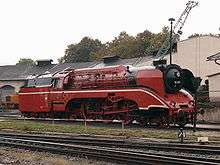DR 18 201
| DR 18 201 | |
|---|---|
|
18 201 | |
| Number(s) |
18 201 since 1970: 02 0201-0 |
| Quantity | 1 |
| Manufacturer | RAW Meiningen |
| Year(s) of manufacture | 1960 |
| Wheel arrangement | 4-6-2 |
| Axle arrangement | 2'C1' h3 |
| Type | S 36.20 |
| Track gauge | 1,435 mm (4 ft 8 1⁄2 in) |
| Length over buffers | 25.145 m (82.50 ft) |
| Empty weight | 102.5 t (100.9 long tons; 113.0 short tons) (without tender) |
| Service weight | 113.6 t (111.8 long tons; 125.2 short tons) |
| Service weight incl. tender | 172 t (169 long tons; 190 short tons) |
| Adhesive weight | 62.3 t (61.3 long tons; 68.7 short tons) |
| Axle load | 20.8 t (20.5 long tons; 22.9 short tons) |
| Top speed | 180 km/h (110 mph) |
| Indicated Power | 1,581 kW (2,120 hp) |
| Driving wheel diameter | 2.3 m (7 ft 7 in) |
| Leading wheel diameter | 1.1 m (3 ft 7 in) |
| Trailing wheel diameter | 1.25 m (4 ft 1 in) |
| No. of cylinders | 3 |
| Cylinder bore | 520 mm (20 in) |
| Piston stroke | 660 mm (26 in) |
| Boiler Overpressure | 16.3 bar (1,630 kPa) |
| Grate area | 4.23 m2 (45.5 sq ft) |
| Superheater area | 83.80 m2 (902.0 sq ft) |
| Evaporative heating area | 206.30 m2 (2,220.6 sq ft) |
| Tender | 2'2' T 34 + additional tender |
| Water capacity | 34,000 l (7,500 imp gal; 9,000 US gal) |
| Fuel | 13,500 l (3,000 imp gal; 3,600 US gal) oil |
| Train heating | Steam |
The German express locomotive, number 18 201 of the Deutsche Reichsbahn in East Germany, appeared in 1960-61 at Meiningen Steam Locomotive Works as a conversion of the Henschel-Wegmann train locomotive 61 002, the tender from 44 468 and parts of H 45 024 and Class 41. It is the fastest operational steam locomotive in the world.
Origin
The motivation for the conversion was firstly that, as a one-off, locomotive 61 002 could not really be used for scheduled services, and secondly that the research institute at VES-M Halle urgently needed locomotives that could do at least 160 km/h in order to test passenger coaches.
For the conversion a DR Class 22 new-design boiler, parts of the unsuccessful high pressure locomotive, H 45 024, (outside cylinders, trailing wheels and rear section of the locomotive frame) as well as the tender of locomotive 44 468 were used. The inside cylinder of the three-cylinder engine was not however taken from 61 002, rather a new one was made. Other technical improvements were a Riggenbach counter-pressure brake and a Giesl ejector. The locomotive was streamlined at the front and over the boiler fittings.
The new locomotive was given its number to commemorate the first German locomotive with a 4-6-2 ('Pacific') wheel arrangement, the Baden IV f of the Baden State Railways (later the DRG Class 18.2).

In 1967 number 18 201 was converted to oil-firing. After the changeover to computerised numbers the engine was given the number 02 0201-0. On 11 October 1972 during a trial run it attained a top speed of 182.4 km/h or 113.3 mph. As a result, it is the fastest, operational steam locomotive in the world, and also holds the world record for the biggest driving wheels (2.30 m in diameter) ever to be fitted to an engine with a 4-6-2 wheel arrangement.
When not required for test runs, locomotive 18 201 was also put in charge of scheduled express trains until well into the 1970s.
Duties as a heritage locomotive

Since 1980 the locomotive has mainly been employed to haul heritage and special trains, often with a second tender, in order to be able to complete long-distance runs without the need to replenish its water. At its birthplace in Meiningen Steam Locomotive Works the engine was handed over to the firm of Dampf-Plus on 4 April 2002 having been completely overhauled. Originally sporting a green livery with white stripes, the engine was repainted between 30 April 2002 and 10 July 2005 in a special red livery (RAL 3003, ruby red) sponsored by the model railway manufacturer, Roco. Today she is once again painted in her traditional green colour (RAL 6020, chromium oxide green).
18 201 today
Locomotive 18 201 belongs to Christian Goldschagg and Axel Zwingenberger, owners of the Dampf-Plus company. Up to January 2006, the locomotive was the subject of a dispute between its owners and the Deutsche Bahn AG, and a sale abroad was contemplated (even the USA and Canada were discussed).

18 201's last special run before took place on 16 July 2005 followed by several months when it was out of service. The special red livery was - as always intended - replaced by the original green paintwork.
On 31 January 2006 the newspaper, Sächsische Zeitung, reported that the guardians of this historic Halle monument were permitting the engine to be stationed elsewhere for a length period; but this did not mean that its export was planned. Meanwhile, the locomotive is stabled at Nossen.
At the celebration of the Schiefe Ebene's 160 years in September 2008 organised by the German Steam Locomotive Museum at Neuenmarkt, 18 201 was finally back in action.
See also
- Deutsche Reichsbahn
- Deutsche Reichsbahn (East Germany)
- List of East German Deutsche Reichsbahn locomotives and railbuses
- List of DRG locomotives and railbuses
- List of preserved steam locomotives in Germany
References
- Weisbrod; Bäzold; Obermayer. Das große Typenbuch deutscher Lokomotiven (in German). Transpress Verlag. ISBN 3-344-70751-5.
- Reuter, Wilhelm. Rekordlokomotiven (in German). Stuttgart: Motorbuch Verlag. ISBN 3-87943-582-0.
| Wikimedia Commons has media related to DR 18 201. |